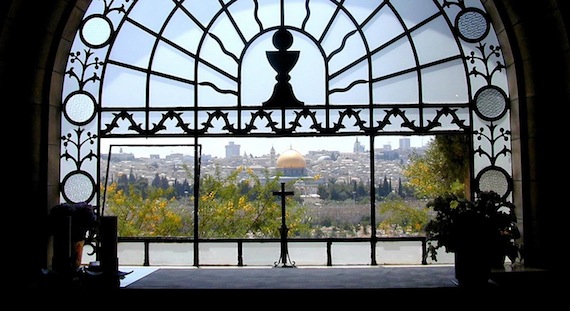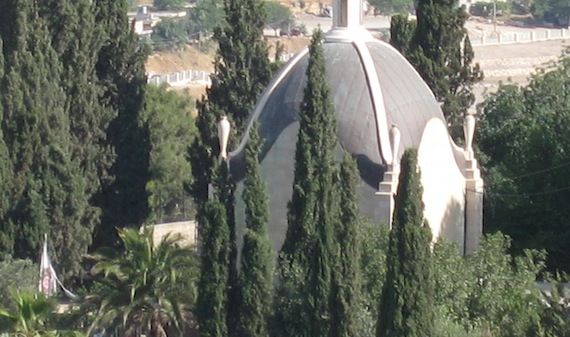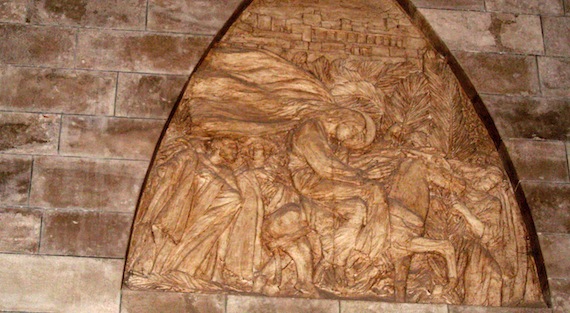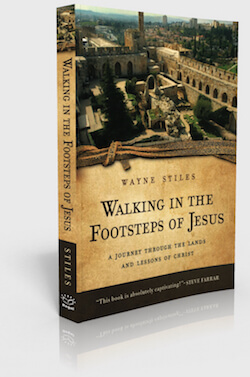As I made my way down the Mount of Olives, I couldn’t help think about the day Jesus rode down the slope on the back of a donkey.
His words that day hardly seemed fitting for a “Triumphal Entry.”

(Photo: Jerusalem from inside the Dominus Flevit Church, courtesy of the Pictorial Library of Bible Lands)
When Jesus saw Jerusalem, He wept over it:
If you had known in this day, even you, the things which make for peace! But now they have been hidden from your eyes. —Luke 19:42
I pondered the words. Why did He say: “this day . . .”?
The prophet Daniel penned a meticulous prediction of the very day when the Messiah would appear in Jerusalem.
It was that very day.
The Dominus Flevit Church—The Lord Wept
We continued the sharp descent on the Mount of Olives by following a narrow road with high walls on either side.
The high wall to my right enclosed the grounds of the Dominus Flevit Church. The chapel and its name memorialize the moment “the Lord wept” over Jerusalem (Luke 19:41). The roof of the quaint chapel of the Dominus Flevit Church resembles the shape of an inverted teardrop.

(Photo: The Dominus Flevit Church, shaped like an inverted teardrop)
I entered the chapel and walked to the altar on the right and the large arced window that frames the city of Jerusalem.
- The window’s decorative wrought-iron bars depict a cup, a loaf, thorns and a cross.
- The capstone above the window supports a stone relief of Jesus riding a donkey with His face in His hands.
As I stared out the window at the city over which the Lord had wept, it seemed as though I gazed through a porthole of time. The wrought-iron elements of Jesus’ Passion Week overshadowed the city.
I could not see Jerusalem without also seeing the cross. Neither could Jesus when He was here that day.

(Photo: The capstone relief of Jesus weeping over Jerusalem in the Dominus Flevit Church)
Daniel’s Prediction—The Triumphal Entry Missed
The Prophet Daniel foretold that exactly 483 Jewish years—or 476 Gregorian years—from the rebuilding of Jerusalem in March 444 B.C., “Messiah the Prince” would appear (Daniel 9:25).
If the religious leaders had taken seriously Daniel’s challenge “to know and discern” the timing (Daniel 9:25), Jesus would have topped the hill as He did in March of AD 33 to see a banner draped over the walls of Jerusalem: “Welcome, Messiah!”
But instead, they rebuked the notion (Luke 19:39).
[slideshow id=38]
(Can’t see slideshow in RSS or email? Click here. All pics courtesy of the Pictorial Library of Bible Lands)
Descending the Mount of Olives
As we left the high walls of Dominus Flevit Church, I noticed the high wall on my left. It overlooked a vast Jewish graveyard.
- Literally thousands of white tombs gave testimony to the hope that when the Messiah comes, “His feet will stand on the Mount of Olives,” and those buried there will stand first in line for blessing (Zechariah 14:4).
- Although the Messiah will raise all Jews from these graves, not every resurrection will rejoice in His presence (Daniel 12:2; Revelation 20:11-15).
- Jesus’ words to Nicodemus remain God’s standard for entrance into His kingdom: “You must be born again.”
The Contrast behind the Walls
I had to marvel at the contrast on either side of me.
- The wall around the cemetery guarded the hope that the Messiah will come one day.
- The wall around the Dominus Flevit Church guarded the belief that He already had come—but was rejected.
Only a narrow, steep road separates these two walls.
But the distance between them is eternal.
Tell me what you think: Why do you think some chose to reject Jesus that day? To leave a comment, just click here.
Dominus Flevit on the Map:

Like This Post? Get the Whole Book!
This post is adapted from Wayne’s book, Walking in the Footsteps of Jesus: A Journey Through the Lands and Lessons of Christ.
• Enjoy an engaging, inspiring, and humorous travelogue that mingles the life-changing truths of Jesus with a walking tour of the Holy Land.
• Experience the Holy Land through the sights, sounds, and tastes of this personal travelogue, and discover how these sacred places influenced the lessons Jesus taught.
You will discover lessons Jesus has for your life.
